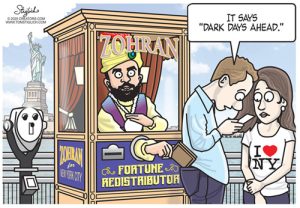“Alexander the Great (All Parts)”
This video on the “Epic History TV channel” details Alexander the Great’s conquests of all of Persia between 334 BC and his early death in 323 BC at age 32. The video makes use of detailed computer simulations that depict the strategies and situations of key battles. It explains his long string of victories over a period of ten years due to his effective strategies and courage as a general, as well has how the newly acquired lands immediately fragmented into empires that fought with each other for power after his death, with most of the regions ultimately being subjugated by Rome a few hundred years later.
Following are points from the video:
— Starting at around 500 BC, Greece became an area of advanced developments in art, philosophy, and military strategy. Its two greatest city-states were Athens where democracy, art, and philosophy flourished; and Sparta which was a militaristic society.
— In 480 BC, Athens and Sparta joined forces to fight off an invasion by the Persian Empire coming from the east. The Spartans won a battle at Thermopylae, then the Greek fleet won a navy battle against the Persians at the Straights of Salamis. However, the Greeks couldn’t prevent the Persians from burning the sacred temples at Athenian Acropolis.
— In 479 BC, The Greeks won a decisive land battle against the Persians at Platea, and it forced the Persians to abandon their invasion.
— The next fifty years were the “golden age” of classical Greece, however tensions between Athens and Sparta and their allies led to war, dragging the Greek world into decades of fighting, where wars between the Greek city-states continued for almost a century, leaving them exhausted and vulnerable to the Greek kingdom of Macedonia to the north.
— At the time, Macedonia was typically thought of being a “backwater” area that was “barely Greek at all,” but under King Phillip II, the region emerged as a powerful military force with the introduction of the “Sarissa,” that was an 18 foot pike that was twice the length of a normal Greek spear, which was wielded by trained infantry in effective formations known as a “Phalanx.”
— In 338 BC, King Phillip’s forces defeated the forces of Thebes and Athens, gaining control of them. Eventually he united all of Greece (except for Sparta) in what was known as the “Hellenic League,” with Phillip as the supreme commander. Phillip then planned a grand campaign against the Persian Empire. However, on the eve of launching his campaign, Phillip was assassinated by his own bodyguard, and he was succeeded by his 20 year old son Alexander, who was tutored by Aristotle and was already an experienced military commander.
— After consolidating his regional power in local skirmishes, Alexander led the Grecian military into Persia in 334 BC, where he embarked on his military campaign of conquest of the region.
— Alexander’s army had about 40 thousand troops from all over Greece. He implemented 9,000 of them in phalanx formations, with 3,00 infantry troops guarding their flanks using shorter spears and shields. The second line of the army was made up of 7,000 Greeks and 5,000 mercenaries. They also employed thousands of elite “skirmishers” armed with javelins, slings and bows, from areas such as Bulgaria. “Shock troops” of 1,800 companion horseback cavalry were implemented as well, armed with spears and swords, with Alexander leading the royal squad in person. There were also 1,800 cavalry from Thessaly, 600 from other parts of Greece, and 900 mounted scouts.
— At the time the Persian empire was divided in provinces, where each was ruled by a governor.
— The initial Persian provinces in Asia Minor attempted a “scorched Earth” policy to try to starve Alexander’s troops that were coming into the region, but people living in the area were unwilling to lay waste to their own provinces, forcing the Persian troops to fight with Alexander’s army at the river Granicus. The Persian army had a cavalry of 10,000 troops, and about 10,000 Greek mercenaries fought behind them, being paid with Persian gold. Persians were unsure if they could trust the Greek mercenaries in combat with the Greeks, so they placed them at the rear. The Greeks won the battle due to aggressiveness combined with good strategy, and they then massacred the Greek mercenaries who remained despite their appeals for mercy.
— Alexander’s troops then moved inland, with the ruler of Sardis surrendering without a fight.
— Alexander then focused on neutralizing Persian naval power in bases around the Mediterranean that could potentially cut his lines of communication back to Greece. He attacked the coastal cities of Miletus and Halicarnassus, where both put up a lot of resistance, however they were both eventually taken by the winter.
— In the spring of 333 BC, Alexander continued his advance into Lycia and Phrygia. At Gordium, he was shown the legendary “Gordium Knot” were a prophecy said that whoever unpicked it would rule all of Asia; and Alexander simply took his sword and sliced it in half.
— 18 months into his campaign, Alexander led his men into Cilicia, and was ready to cross into Syria when he was challenged by Darius’ troops who outnumbered Alexander 2 to 1 at the Battle of Issus. Alexander won the battle due to aggressiveness, quick responsiveness to battlefield conditions to protect the phalanxes, and sticking with the fight until the opposing troops fled. It was said that there were so many dead Persians that they were used to fill a deep ravine. The spoils of victory were the wife, mother, and three children of Darius, who were all well-treated.
— In 332 BC, Alexander focused on the coastal cities of Phoenicia in the eastern Mediterranean, and the island city of Tyre resisted and fought fiercely; however Alexander built a causeway to the island with siege towers, and after seven months the city walls were breached with most of its citizens being killed or enslaved. Gaza was also taken by siege.
— Alexander continued to Pelusium on the Nile Delta, where the Perisan governor of Egypt surrendered the entire province to Alexander along with the royal treasury. At Memphis, priests welcomed Alexander as their liberator from Persian rule and crowned him Pharaoh. Than at the mouth the Nile, he founded the city of Alexandria, and traveled to Siwah where the priests welcomed his as “Son of Amun”— meaning “King of the Gods.”
— In 331 BC Alexander once again located himself at Tyre on the Mediterranean coast. Despite his great victories over the Persians, many Greeks regarded Alexander as a tyrant, such as King Agis III of Sparta who launched a revolt against Macedonia in Greece with Persian support. However, the Macedonians were able to overwhelm the Spartans with their new-found military power, and King Agis died in the battle.
— Once his base in Greece was secure, Alexander advanced once again eastward into Persia. He was offered half of the Persian Empire and the daughter of King Darius in exchange for peace in the region, but he rejected the offer and advanced into the region toward battles.
— The Battle of Gaugamela was fought with a large amount of troops, where Alexander was outnumbered by a factor of 2 to 1. Alexander won the battle by tricking the opposing forces into moving into vulnerable positions in a trap, where chariots forces were neutralized by expert javelin throwers and by lanes being opened to allow the chariots to pass through without causing damage. Alexander lost a few hundred men while the Persians lost thousands.
— Alexander then headed to Babylon, where he entered the city being recognized as its new rightful ruler, and the same happened at the city of Susa.
— In the Zagros mountains at a pass known as the “Persian Gates,” Persian forces fought Alexander for a month, until the Greeks found a mountain path that bypassed their position, allowing them to encircle and wipe out their defenders.
— At 330 BC, Alexander reached Persepolis, which was the empire’s ceremonial capital. He order Persepolis to be pillaged and burned as retribution for Persia invading Greece and burning its temples 150 years earlier in 480 BC. [Note: See this video that recreates what Persepolis looked like at the time.]
— King Darius fled to Ecbatna in the hopes of raising a new army, but he was murdered by one of his own governors named Bessus who proclaimed himself the empire’s new ruler.
— Alexander paused to organize his vast new empire, and he then appointed viceroys to rule the provinces on his behalf, keeping several Persians in their posts. He then moved east to find and the kill the new usurper and subjugate the eastern provinces.
— In Aria, which is present-day Afghanistan, a Persian governor Satibarzanes launched a revolt after initially pretending to submit to Alexander. The rebellion was crushed and he was killed in combat by a Greek cavalry officer.
— Alexander learned to a plot to kill him by some of his most high ranking officers and he executed them.
— In 329, Alexander resumed his pursuit of Bessus, where he was betrayed by his own men and handed over to Alexander in chains. Alexander had him sent back to Persia to be executed as a “king slayer.”
— Alexander then pushed on into present-day Tajikistan, where he fought off attacks by local tribes. He had at least reached the limits of the Persian Empire. The frontier was frequently raided by nomads, and Alexander lured them into a decisive battle at Jaxartes, which eliminated them and put an end to the raids.
— At this point, many of the Macedonian troops were unhappy with Alexander since most have not seen their homes in years, and they were unhappy that Alexander was adopting some of the customs of the Persian people. Alexander killed one of his best generals Cleitus in a drunken argument at Maracanda, and his growing arrogance was alienating many of his comrades. He even wanted to have his countrymen perform a traditional Persian ritual of “prostrating” themselves to him, but Greeks saw it as blasphemy and he was forced to back down.
— Another plot to assassinate Alexander was uncovered in Bactra in 327 BC, where the plotters were tortured and stoned to death. Alexander’s historian was also implicated in the plot (known as “the pages plot”) and he was put in prison, where he later died.
— Alexander then married Roxana, the daughter of a Bactrian lord, which brought peace in the region.
— Alexander then continued to advance into present-day Pakistan toward the Indus river valley in India, where the provinces did not recognize his kingship. He won various skirmishes on the way, and took the capital of Massaga which was ruled by a queen named Cleophis who legend says he had a son with. The ruler of Taxila formed an alliance with Alexander, where they marched on King Porus of Pauravas and fought a brutal battle where they fought against troops of war elephants. It was Alexander’s costliest battle, but he did win.
— Alexander then wanted to push into India, but his army mutinied after being made to march thousands of miles and fight countless battles without seeing their homes in eight years! Thus they refused to go any further, so Alexander marched them toward the coast, fighting some skirmishes on the way where Alexander was wounded.
— Upon reaching the coast, part of the army boarded ships and returned to Persia by sea, while the rest of the army marched through the desert in present-day Pakistan, where extreme heat and shortages of food and water led to terrible suffering and the deaths of many.
— When he arrived in Persia, Alexander executed several of his viceroys who were accused of ruling unjustly and robbing temples and tombs during his long absence in the east.
— In Susa, Alexander arranged a mass marriage of Macedonian officers to 80 persian noble women in order to strengthen the bonds between the kingdoms, and Alexander married two Persian princesses. He also paid all of this soldier’s debts and ordered thirty thousand youths from across the empire to be trained in the Macedonian art of war.
— At Opis, Alexander’s troops mutinied due to Alexander’s preference for Persian advisors and Persian ways. Alexander had the ringleaders executed and he gave a speech reminding them of the glories that they won together.
— At Ecbatana, Alexander’s closest friend Haphaestion died of fever, which caused him to be grief stricken. He also waged a successful campaign against the Cossaea, who not even the Persian kings were able to subdue.
— When Alexander returned to Babylon, he was met by kings from distant parts of the world such as regions of Europe, who came to recognize his achievements.
— In 323 BC, while Alexander was planning his next campaign to Arabia and beyond, he was stricken with fever and died days later, aged at just 32. The cause of his death was never established, it may have been malaria, cholera, typhus, or poision.
— Alexander’s decade-long campaign created one of the greatest empires ever known, stretching from Greece to Pakistan. However the empire was vast and unstable, held together only by him and with no plans left for succession. Therefore, after he died, his generals began fighting among themselves to carve out their own empires, and the region fragmented in what is known as “the wars of the successors” where Alexander’s widow Roxana and his young son where murdered. Alexander’s gold Sarcophagus was even hijacked and lost en route to Alexandria, Egypt.
— Alexander’s achievements ushered in the “Hellenistic Age” in Greece from between 323 and 31 BC, where Greek ideas spread across his former empire.
— Some of the successor kingdoms of his empire were short-lived, while others endured for centuries, but all would fall to new forces— many ultimately falling to the rising power of Rome.
Article Tree
| A Summary of the History of the World, in Videos |
| THE GREEK ERA |
| Video: “Alexander the Great (All Parts)” |





















